A Simple Light-Use-Efficiency Model to Estimate Wheat Yield in the Semi-Arid Areas
Abstract
:1. Introduction
2. Materials and Methods
2.1. In Situ and Satellite Data
2.1.1. Study Area
2.1.2. Field Data
2.1.3. Satellite Data
- -
- For the 2002/2003 agricultural season, 10 images acquired by Landsat 7 Enhanced Thematic Mapper Plus (ETM+), SPOT4-HRVIR and SPOT5-HRG were exploited.
- -
- -
- During the 2012/2013 agricultural season, 18 images obtained from the SPOT4and Landsat 8 Operational Land Imager (OLI) sensors were used. These images were acquired during 5 months between 31 January and 15 June 2013 [43]. Radiometric correction was performed by the Multi-Sensor Atmospheric Correction Software–Prototype [45,46].
2.2. Proposed Model
2.2.1. Dry Matter
- -
- Climatic efficiency,
- -
- Interception efficiency,
- -
- Conversion efficiency,
- Water stress coefficient
- Temperature stress coefficient
2.2.2. Harvest Index, HI
- -
- -
- Constant value of HI (HI = HI0).
2.2.3. Model Calibration and Validation
- -
- Inverting the Equation (11) to determine the local values of the parameter as follows:
- -
- Adjustment of Equation (12), by using data for the fields Ci (i = 1 to 4), to determine the local values of , , and HI0.
2.2.4. Model Evaluation Metrics
3. Results and Discussion
3.1. Calibration of
- ▪
- t1 = 230 °C-day: This time corresponds to the stage 2 of the Brower scale. This shows that t1 coincides perfectly with the start of tillering. This result is reinforced by Hadria et al. [42], who obtained tillering at a CGDD equivalent to 260 °C-day. This work was calibrated and validated by the STICS model on wheat crops over our study area R3.
- ▪
- t2 = 620 °C-day: Is the thermal time corresponding to the start of the plateau phase. This time coincides with the stage 4 of the Brower scale wich corresponds to the end of tillering and the start of upstream stages. This time is characterized by the transition from leaf production to that of spikelets [85]. The obtained t2 value is slightly lower than the CGDD = 696 °C-day estimated by Toumi et al. [66], for the start of the maximum of cover fraction.
- ▪
- t3 = 1186 ° C-day: Is the time of the end of the plateau phase which corresponds to the time between stages 16 and 17 of the Brower scale. It coincides with the end of flowering and the beginning of maturity of the wheat crop.
- ▪
- t4 = 1500 °C-day: Corresponds to the end of maturity of the wheat. This time coincides well with the CGDD at wheat maturity (1462 °C-day) obtained by Toumi et al. [66].
3.2. Calibration of HI
3.3. Model Validation by Using the Observed Data
3.4. Model Evalution against AquaCrop Model
4. Conclusions
Author Contributions
Funding
Acknowledgments
Conflicts of Interest
Appendix A
- Comparison of the two slopes (a1 and a2): The null hypothesis (often denoted H0) is: a1 = a2. The observable value of the Fisher-Snedecor distribution (Fobs) is calculated as:with
- Comparison of the two intercepts (b1 and b2): The null hypothesis (H0) is: b1 = b2. The observable value of the Fisher-Snedecor distribution (Fobs) is calculated as:with
References
- Le Page, M.; Zribi, M. Analysis and predictability of drought in Northwest Africa using optical and microwave satellite remote sensing products. Sci. Rep. 2019, 9, 1466. [Google Scholar] [CrossRef] [PubMed] [Green Version]
- Dettori, M.; Cesaraccio, C.; Duce, P. Simulation of climate change impacts on production and phenology of durum wheat in Mediterranean environments using CERES-Wheat model. Field Crops Res. 2017, 206, 43–53. [Google Scholar] [CrossRef]
- Bolle, H.J. Mediterranean Climate: Variability and Trends; Springer: Berlin/Heidelberg, Germany, 2002; ISBN 978-3540438380. [Google Scholar]
- Bleu, P. Etat de L’environnement et du Développement en Méditerranée; Centre D’activités Régionales PNUD/PAM: Athens, Greece, 2009; p. 208. [Google Scholar]
- Matesanz, S.; Valladares, F. Ecological and Evolutionary Responses of Mediterranean Plants to Global Change. Environ. Exp. Bot. 2014, 103, 53–67. [Google Scholar] [CrossRef] [Green Version]
- Balaghi, R.; Tychon, B.; Eerens, H.; Jlibene, M. Empirical regression models using NDVI, rainfall and temperature data for the early prediction of wheat grain yields in Morocco. Int. J. Appl. Earth Obs. Geoinf. 2008, 10, 438–452. [Google Scholar] [CrossRef] [Green Version]
- Kharrou, M.H.; Er-Raki, S.; Chehbouni, A.; Duchemin, B.; Simonneaux, V.; Le Page, M.; Ouzine, L.; Jarlan, L. Water use efficiency and yield of winter wheat under different irrigation regimes in a semi-arid region. Agric. Sci. 2011, 2, 273–282. [Google Scholar] [CrossRef] [Green Version]
- EL Jarroudi, M.; Kouadio, L.; Bertrand, M.; Curnel, Y.; Giraud, F.; Delfosse, P.; Hoffmann, L.; Oger, R.; Tychon, B. Integrating the impact of wheat fungal diseases in the Belgian crop yield forecasting system (B-CYFS). Eur. J. Agron. 2012, 40, 8–17. [Google Scholar] [CrossRef]
- Pinter, P.J.; Hatfield, J.L.; Schepers, J.S.; Barnes, E.M.; Moran, S.M.; Daughtry, C.S.T.; Upchurch, D.R. Remote sensing for crop management. Photogramm. Eng. Remote Sens. 2003, 69, 647–664. [Google Scholar] [CrossRef] [Green Version]
- Khabba, S.; Jarlan, L.; Er-Raki, S.; Le Page, M.; Ezzahar, J.; Boulet, G.; Simonneaux, V.; Kharrou, M.H.; Hanich, L.; Chehbouni, A. The SudMed program and the Joint International Laboratory TREMA: A decade of water transfer study in the Soil-PlantAtmosphere system over irrigated crops in semi-arid area. Procedia Environ. Sci. 2013, 19, 524–533. [Google Scholar] [CrossRef] [Green Version]
- Jarlan, L.; Khabba, S.; Er-Raki, S.; Le Page, M.; Hanich, L.; Fakir, Y.; Merlin, O.; Escadafal, R. Remote Sensing of Water Resources in Semi-Arid Mediterranean Areas: The joint international laboratory TREMA. Int. J. Remote Sens. 2015, 36, 4879–4917. [Google Scholar] [CrossRef]
- Geerts, S.; Raes, D. Deficit Irrigation as an On-Farm Strategy to Maximize Crop Water Productivity in Dry Areas. Agric. Water Manag. 2009, 96, 1275–1284. [Google Scholar] [CrossRef] [Green Version]
- Sinclair, T.R.; Seligman, N.G. Crop Modeling: From Infancy to Maturity. Agron. J. 1996, 88, 698–704. [Google Scholar] [CrossRef]
- Gowda, P.T.; Satyareddi, S.A.; Manjunath, S.B. Crop Growth Modeling: A Review. Res. Rev. J. Agric. Allied Sci. 2013, 2, 1–11. [Google Scholar]
- Oteng-Darko, P.; Yeboah, S.; Addy, S.N.T.; Amponsah, S.; Danquah, E.O. Crop modeling: A tool for agricultural research—A review. E3 J. Agric. Res. Dev. 2013, 2, 1–6. [Google Scholar]
- Jiang, R.; Wang, T.; Shao, J.; Guo, S.; Zhu, W.; YU, Y.; Chen, S.; Hatano, R. Modeling the biomass of energy crops: Descriptions, strengths and prospective. J. Integr. Agric. 2017, 16, 1197–1210. [Google Scholar] [CrossRef]
- Raes, D.; Steduto, P.; Hsiao, T.C.; Fereres, E. AquaCrop—The FAO crop model to simulate yield response to water: II. Main algorithms and software description. Agron. J. 2009, 101, 438–447. [Google Scholar] [CrossRef] [Green Version]
- Brisson, N.; Gary, C.; Justes, E.; Roche, R.; Mary, B.; Ripoche, D.; Zimmer, D.; Sierra, J.; Bertuzzi, P.; Burger, P.; et al. An overview of the crop model stics. Eur. J. Agron. 2003, 18, 309–332. [Google Scholar] [CrossRef]
- Jones, J.W.; Hoogenboom, G.; Porter, C.H.; Boote, K.J.; Batchelor, W.D.; Hunt, L.A.; Wilkens, P.W.; Singh, U.; Gijsman, A.J.; Ritchie, J.T. The DSSAT cropping system model. Eur. J. Agron. 2003, 18, 235–265. [Google Scholar] [CrossRef]
- McCown, R.; Hammer, G.; Hargreaves, J.; Holzworth, D.; Freebairn, D. APSIM: A novel software system for model development, model testing and simulation in agricultural systems research. Agric. Syst. 1996, 50, 255–271. [Google Scholar] [CrossRef]
- Spitters, C.J.T.; Van Keulen, H.; Van Kraalingen, D.W.G. A simple and universal crop growth simulator: SUCROS87, In Simulation and Systems Management in Crop Protection; Rabbinge, R., Ward, S.A., van Laar, H.H., Eds.; PUDOC: Wageningen, The Netherlands, 1989; pp. 147–181. [Google Scholar]
- Diepen, C.V.; Wolf, J.; Keulen, H.V.; Rappoldt, C. WOFOST: A simulation model of crop production. Soil Use Manag. 1989, 5, 16–24. [Google Scholar] [CrossRef]
- Jones, C.A.; Kiniry, J. CERES-Maize: A Simulation Model of Maize Growth and Development; Texas A & M University Press: College Station, TX, USA, 1986. [Google Scholar]
- Potter, C.S.; Randerson, J.T.; Field, C.B.; Matson, P.A.; Vitousek, P.M.; Mooney, H.A.; Klooster, S.A. Terrestrial Ecosystem Production: A Process Model Based on Global Satellite and Surface Data. Glob. Biogeochem. Cycles 1993, 7, 811–841. [Google Scholar] [CrossRef]
- 25. Royo, C.; Aparicio, N.; Villegas, D.; Casadesus, J.; Monneveux, P.; Araus, J.L. Usefulness of spectral reflectance indices as durum wheat yield predictors under contrasting Mediterranean conditions. Int. J. Remote Sens. 2003, 17, 4403–4419. [Google Scholar] [CrossRef]
- Vicente-Serrano, S. Evaluating the Impact of Drought Using Remote Sensing in a Mediterranean, Semi-arid Region. Nat. Hazards 2007, 40, 173–208. [Google Scholar] [CrossRef]
- Tucker, C.J.; Holben, B.N.; Elgin, J.H.; McMurtrey, J.E. Relationships of spectral data to grain yield variation. Photogramm. Eng. Remote Sens. 1980, 46, 657–666. [Google Scholar]
- Jianqiang, R.; Zhongxin, C.; Qingbo, Z.; Huajun, T. Regional yield estimation for winter wheat with MODIS-NDVI data in Shandong, China. Int. J. Appl. Earth Obs. Geoinf. 2008, 10, 403–413. [Google Scholar]
- Becker-Reshef, I.; Justice, C.; Sullivan, M.; Vermote, E.; Tucker, C.; Anyamba, A.; Small, J.; Pak, E.; Masuoka, E.; Schmaltz, J.; et al. Monitoring Global Croplands with Coarse Resolution Earth Observations: The Global Agriculture Monitoring (GLAM) Project. Remote Sens. 2010, 2, 1589–1609. [Google Scholar] [CrossRef] [Green Version]
- Belaqziz, S.; Khabba, S.; Er-Raki, S.; Jarlan, L.; Le Page, M.; Kharrou, M.H.; El Adnani, M.; Chehbouni, A. A new Irrigation Priority Index based on remote sensing data for assessing the networks irrigation scheduling. Agric. Water Manag. 2013, 119, 1–9. [Google Scholar] [CrossRef]
- Chahbi, A.; Zribi, M.; Lili-Chabaane, Z.; Duchemin, B.; Shabou, M.; Mougenot, B.; Boulet, G. Estimation of the dynamics and yields of cereals in a semi-arid area using remote sensing and the SAFY growth model. Int. J. Remote Sens. 2014, 35, 1004–1028. [Google Scholar] [CrossRef] [Green Version]
- Arkebauer, T.J.; Weiss, A.; Sinclair, T.R.; Blum, A. In defense of radiation use efficiency: A response to Demetriades-Shah. Agric. For. Meteorol. 1994, 68, 221–227. [Google Scholar] [CrossRef]
- Monteith, J.L. Solar radiation and productivity in tropical ecosystems. J. Appl. Ecol. 1972, 9, 747–766. [Google Scholar] [CrossRef] [Green Version]
- Spitters, C.; Schapendonk, A. Evaluation of breeding strategies for drought tolerance in potato by means of crop growth simulation. Plant Soil 1990, 123, 193–203. [Google Scholar] [CrossRef]
- Prince, S.D.; Goetz, S.J.; Goward, S.N. Monitoring primary production from Earth observing satellites. Water Air. Soil. Pollut. 1995, 82, 509–522. [Google Scholar] [CrossRef]
- Tucker, C.; Sellers, P. Satellite remote sensing of primary production. Int. J. Remote Sens. 1986, 7, 1395–1416. [Google Scholar] [CrossRef]
- Yu, D.; Shi, P.; Shao, H.; Zhu, W.; Pan, Y. Modelling net primary productivity of terrestrial ecosystems in East Asia based on an improved CASA ecosystem model. Int. J. Remote Sens. 2009, 30, 4851–4866. [Google Scholar] [CrossRef]
- Yuan, W.; Cai, W.; Xia, J.; Chen, J.; Liu, S.; Dong, W.; Merbold, L.; Law, B.; Arain, A.; Beringer, J. Global comparison of light use efficiency models for simulating terrestrial vegetation gross primary production based on the LaThuile database. Agric. For. Meteorol. 2014, 192–193, 108–120. [Google Scholar] [CrossRef]
- Maas, S.J. Parameterized model of gramineous crop growth: I. Leaf area and dry mass simulation. Agron. J. 1993, 85, 348–353. [Google Scholar] [CrossRef]
- Simonneaux, V.; Duchemin, B.; Helson, D.; Er-Raki, S.; Olioso, A.; Chehbouni, A. The use of high-resolution image time series for crop classification and evapotranspiration estimate over an irrigated area in central Morocco. Int. J. Remote Sens. 2008, 29, 95–116. [Google Scholar] [CrossRef] [Green Version]
- Duchemin, B.; Hadria, R.; Erraki, S.; Boulet, G.; Maisongrande, P.; Chehbouni, A.; Escadafal, R.; Ezzahar, J.; Hoedjes, J.C.B.; Kharrou, M.H.; et al. Monitoring wheat phenology and irrigation in Central Morocco: On the use of relationships between evapotranspiration, crops coefficients, leaf area index and remotely-sensed vegetation indices. Agric. Water Manag. 2006, 97, 1–27. [Google Scholar] [CrossRef]
- Hadria, R.; Khabba, S.; Lahrouni, A.; Duchemin, B.; Chehbouni, A.; Ouzine, L.; Carriou, J. Calibration and validation of the shoot growth module of STICS crop model: Application to manage water irrigation in the Haouz plain, Marrakech plain. Arab. J. Sci. Eng. 2007, 32, 87–101. [Google Scholar]
- Le Page, M.; Toumi, J.; Khabba, S.; Hagolle, O.; Tavernier, A.; Kharrou, M.H.; Er-Raki, S.; Huc, M.; Kasbani, M.; El Moutamanni, A.; et al. A Life-Size and Near Real-Time Test of Irrigation Scheduling with a Sentinel-2 Like Time Series (SPOT4-Take5) in Morocco. Remote Sens. 2014, 6, 11182–11203. [Google Scholar] [CrossRef] [Green Version]
- Rahman, H.; Dedieu, G. SMAC: A simplified method for the atmospheric correction of satellite measurements in the solar spectrum. Int. J. Remote Sens. 1994, 15, 123–143. [Google Scholar] [CrossRef]
- Hagolle, O.; Dedieu, G.; Mougenot, B.; Debaecker, V.; Duchemin, B.; Meygre, A. Correction of aerosol effects on multi-temporal images acquired with constant viewing angles: Application to Formosat-2 images. Remote Sens. Environ. 2008, 112, 1689–1701. [Google Scholar] [CrossRef] [Green Version]
- Hagolle, O.; Sylvander, S.; Huc, M.; Clesse, D.; Houpert, L.; Daniaud, F.; Leroy, M. SPOT4 (Take5): Simulation of Sentinel-2 Time Series on 45 Large Sites. In Proceedings of the ESA’s Living Planet Symposium, Edinburg, UK, 9–13 September 2013; Volume 4, pp. 2–13. [Google Scholar]
- Monteith, J.L. Climate and Efficiency of Crop Production in Britain. Philos. Trans. R. Soc. Lond. B 1977, 281, 277–294. [Google Scholar]
- McCree, K.J. Test of current definitions of photosynthetically active radiation against leaf photosynthesis data. Agric. Meteorol. 1972, 10, 443–453. [Google Scholar] [CrossRef]
- Ross, J.; Nilson, T. Radiation exchange in plant canopies. In Heat and Mass Transfer in the Biosphere; De Vries, D.A., Afgan, H.H., Eds.; Scripta: Washington, DC, USA, 1975; pp. 327–336. [Google Scholar]
- Varlet-Grancher, C. Analyse du Rendement de la Conversion de L’énergie Solaire par un Couvert Végétal; Univ. Paris-Sud, Orsay: Paris, France, 1982; p. 144. [Google Scholar]
- Werker, A.R.; Jaggard, K.W. Dependence of sugar beet yield on light interception and evapotranspiration. Agric. For. Meteorol. 1998, 89, 229–240. [Google Scholar] [CrossRef]
- Lobell, D.B. The use of satellite data for crop yield gap analysis. Field Crops Res. 2013, 143, 56–64. [Google Scholar] [CrossRef] [Green Version]
- Sellers, P.J.; Mintz, Y.C.S.Y.; Sud, Y.E.A.; Dalcher, A. A simple biosphere model (SiB) for use within general circulation models. J. Atmos. Sci. 1986, 43, 505–531. [Google Scholar] [CrossRef] [Green Version]
- Ledent, J.F. Sur le calcul du coefficient d’extinction du rayonnement solaire incident direct dans un couvert végétal. Oecology 1977, 12, 291–300. [Google Scholar]
- El Hisse, M.; Khabba, S.; Lahrouni, A.; Ledent, J.-F.; Bennouna, B. Quantification de l’absorption de la lumière par des plantes à géométrie complexe—cas du maïs. Phys. Chem. News 2006, 30, 62–65. [Google Scholar]
- Laguette, S.; Vidal, A.; Vossen, P. Télédétection et estimation des rendements en blé en Europ. Ingénieur EAT 1997, 12, 19–33. [Google Scholar]
- Gosse, G.; Varlet-Grancher, C.; Bonhomme, R.; Chartier, M.; Allirand, J.M.; Lemaire, G. Maximum dry-matter production and solar radiation intercepted by a canopy. Agronomie 1986, 6, 47–56. [Google Scholar] [CrossRef] [Green Version]
- Gallagher, J.; Biscoe, P. Radiation absorption, growth and yield of cereals. J. Agric. Sci. 1978, 91, 47–60. [Google Scholar] [CrossRef]
- Baret, F.; Guyot, G.; Major, D.J. Crop biomass evaluation using radiometric measurements. Photogrammetrie 1989, 43, 241–256. [Google Scholar] [CrossRef]
- Begue, A.; Myneni, R. Operational relationships between NOAA-advanced very high resolution radiometer vegetation indices and daily fraction of absorbed photosynthetically active radiation, established for sahelian vegetation canopies. J. Geophys. Res. 1996, 101, 21275–21289. [Google Scholar] [CrossRef]
- Spiertz, J.H.J. Grain formation and assimilate partitioning in wheat-Ear development, assimilate supply and grain growth of wheat. In Simulation of Plant Growth and Crop Production; Penning de Vries, F.W.T., van Laar, H.H., Eds.; Pudoc: Wageningen, The Netherlands, 1982; pp. 136–144. [Google Scholar]
- Howell, T.A.; Dusek, D.A. Comparison of vapor-pressure-deficit calculation methods—Southern high plains. J. Irrig. Drain. Eng. 2001, 127, 329–330. [Google Scholar] [CrossRef]
- Asrar, G.; Hipps, L.E.; Kanemasu, E.T. Assessing solar energy and water use efficiencies in winter wheat: A case study. Agric. For. Meteorol. 1984, 31, 47–58. [Google Scholar] [CrossRef]
- Coulson, C.L. Radiant energy conversion in three cultivars of Phaseolus vulgaris. Agric. For. Meteorol. 1985, 35, 21–29. [Google Scholar] [CrossRef]
- Begue, A.; Desprat, J.F.; Imbernon, J.; Baret, F. Radiation use efficiency of pearl millet in the Sahelian zone. Agric. For. Meteorol. 1991, 56, 93–110. [Google Scholar] [CrossRef]
- Toumi, J.; Er-Raki, S.; Ezzahar, J.; Khabba, S.; Jarlan, L.; Chehbouni, A. Performance assessment of AquaCrop model for estimating evapotranspiration, soil water content and grain yield of winter wheat in Tensift Al Haouz (Morocco): Application for irrigation management. Agric. Water Manag. 2016, 163, 219–235. [Google Scholar] [CrossRef]
- Jackson, R.D.; Pinter, P.J.; Reginato, R.J.; Idso, S.B. Detection and evaluation of plant stresses for crop management decisions. IEEE Trans. Geosci. Remote Sens. 1986, 24, 99–106. [Google Scholar] [CrossRef]
- Allen, R.G.; Pereira, L.S.; Raes, D.; Smith, M. Crop Evapotranspiration: Guidelines for Computing Crop Water Requirements; FAO Irrigation and Drainage, Paper N° 56; FAO: Rome, Italy, 1998; p. 300. [Google Scholar]
- Porter, J.R.; Gawith, M. Temperatures and the Growth and Development of Wheat: A Review. Eur. J. Agron. 1999, 10, 23–36. [Google Scholar] [CrossRef]
- Sinclair, T.R.; Muchow, R.C. Radiation use efficiency. Adv. Agron. 1999, 65, 215–265. [Google Scholar]
- Moot, D.J.; Jamieson, P.D.; Henderson, A.L.; Ford, M.A.; Porter, J.R. Rate of change of harvest index during grain filling in wheat. J. Agric. Sci. 1996, 126, 387–395. [Google Scholar] [CrossRef]
- Lecoeur, J.; Sinclair, T.R. Harvest index increase during seed growth of field pea. Eur. J. Agron 2001, 14, 173–180. [Google Scholar] [CrossRef]
- Soltani, A.; Meinke, H.; De Voil, P. Assessing linear interpolation to generate daily radiation and temperature data for use in crop simulations. Eur. J. Agron. 2004, 21, 133–148. [Google Scholar] [CrossRef]
- Ritchie, J.T.; Otter, S. Description and Performance of CERES-Wheat: A User-Oriented Wheat Yield Model. US Dep. Agric. ARS 1985, 38, 159. [Google Scholar]
- Brisson, N.; Mary, B.; Ripoche, D.; Jeuffroy, M.H.; Ruget, F.; Nicoullaud, B.; Gate, P.; Devienne-Baret, F.; Antonioletti, R.; Durr, C.; et al. STICS: A generic model for the simulation of crops and their water and nitrogen balances. I. Theory and parameterization applied to wheat and corn. Agronomie 1998, 18, 311–346. [Google Scholar] [CrossRef]
- Raes, D.; Steduto, P.; Hsiao, T.C.; Fereres, E. AquaCrop, Version 4.0. Reference Manual; FAO, Land and Water Division: Rome, Italy, 2012; p. 130. [Google Scholar]
- Kogan, F.N. Remote sensing of weather impacts on vegetation in nonhomogeneous areas. Int. J. Remote Sens. 1990, 11, 1405–1419. [Google Scholar] [CrossRef]
- Davenport, M.L.; Nicholson, S. On the relation between rainfall and the Normalized Difference Vegetation Index for diverse vegetation types in East Africa. Int. J. Remote Sens. 1993, 14, 2369–2389. [Google Scholar] [CrossRef]
- Maselli, F.; Rembold, F. Analysis of GAC NDVI data for cropland identification and yield forecasting in Mediterranean African countries. Photogramm. Eng. Remote Sens. 2001, 67, 593–602. [Google Scholar]
- Walsh, S.J. Comparison of NOAA-AVHRR data to meteorological drought indices. Photogramm. Eng. Remote Sens. 1987, 53, 1069–1074. [Google Scholar]
- Cannizzaro, G.; Maselli, F.; Caroti, L.; Bottai, L. Use of NOAA-AVHRR NDVI data for climatic characterization of Mediterranean areas. In Mediterranean Desertification: A Mosaic of Processes and Responses; Geeson, N.A., Brandt, G.J., Thornes, J.B., Eds.; John Wiley and Sons: New York, NY, USA, 2002; pp. 47–54. [Google Scholar]
- Ichii, K.; Kawabata, A.; Yamaguchi, Y. Global correlation analysis for NDVI and NDVI trends: 1982–1990. Int. J. Remote Sens. 2002, 23, 3873–3878. [Google Scholar] [CrossRef]
- Steduto, P.; Hsiao, T.C.; Raes, D.; Fereres, E. AquaCrop-the FAO crop model to simulate yield response to water: I. Concepts and underlying principles. Agron. J. 2009, 101, 426–437. [Google Scholar] [CrossRef] [Green Version]
- Coursol, J. Technique Statistique des Modèles Linéaires. 1–Aspects Théoriques; CIMPA: Nice, France, 1983. [Google Scholar]
- Karrou, M. Conduite du blé au Maroc; Editions INRA: Rabat, Morocco, 2003. [Google Scholar]
- Muchow, R.C.; Davis, R. Effect of nitrogen on the comparative productivity of maize, wheat and sorghum in a semi-arid tropical environment. II. Radiation interception and biomasse accumulation. Field Crops Res. 1988, 18, 17–30. [Google Scholar] [CrossRef]
- Muchow, R.C. An analysis of the effects of water deficits on grain legumes grown in a semi-arid tropical environment in terms of radiation interception and its efficiency of use. Field Crops Res. 1985, 11, 309–323. [Google Scholar] [CrossRef]
- Moriondo, M.; Maselli, F.; Bindi, M. A simple model of regional wheat yield based on NDVI data. Eur. J. Agron. 2007, 26, 266–274. [Google Scholar] [CrossRef]
- Jin, F.; Wang, H.; Xu, H.; Liu, T.; Tang, L.; Wang, X.; Chen, W. Comparisons of plant-type characteristics and yield components in filial generations of Indica × Japonica crosses grown in different regions in China. Field Crops Res. 2013, 154, 110–118. [Google Scholar] [CrossRef]
- Hammer, G.L.; Muchow, R.C. Assessing climatic risk to wheat production in water-limited subtropical environments. I. Development and testing of a simulation model. Field Crops Res 1994, 36, 221–234. [Google Scholar] [CrossRef]
- Mkhabela, M.S.; Bullock, P.R. Performance of the FAO AquaCrop model for wheat grain yield and soil moisture simulation in Western Canada. Agric. Water Manag. 2012, 110, 16–24. [Google Scholar] [CrossRef]
- Nassah, H. Investigation sur la Percolation Profonde en Zone Irriguée par Bilan hydrique et Télédétection; Cas de la plaine du Haouz, Bassin de Tensift, Maroc. Ph.D. Thesis, Cadi Ayyad University, Marrakech, Morocco, 2018; p. 164. [Google Scholar]
- Porter, J.R.; Jamieson, P.D.; Wilson, D.R. Comparison of the wheat simulation models AFRCWHEAT2, CERES Wheat and SWHEAT of non-limiting conditions of crop growth. Field Crops Res. 1993, 33, 131–157. [Google Scholar] [CrossRef]
- Xiangxiang, W.; Quanjiu, W.; Jun, F.; Qiuping, F. Evaluation of the AquaCrop model for simulating the impact of water deficits and different irrigation regimes on the biomass and yield of winter wheat grown on China’s Loess Plateau. Agric. Water Manag. 2013, 129, 95–104. [Google Scholar] [CrossRef]
- Shelestov, A.; Lavreniuk, M.; Kussul, N.; Novikov, A.; Skakun, S. Exploring Google Earth Engine Platform for Big Data Processing: Classification of Multi-Temporal Satellite Imagery for Crop Mapping. Front. Earth Sci. 2017, 5, 1–10. [Google Scholar] [CrossRef] [Green Version]
- Lobell, D.B.; Thau, D.; Seifert, C.; Engle, E.; Little, B. A scalable satellite-based crop yield mapper. Remote Sens. Environ. 2015, 164, 324–333. [Google Scholar] [CrossRef]
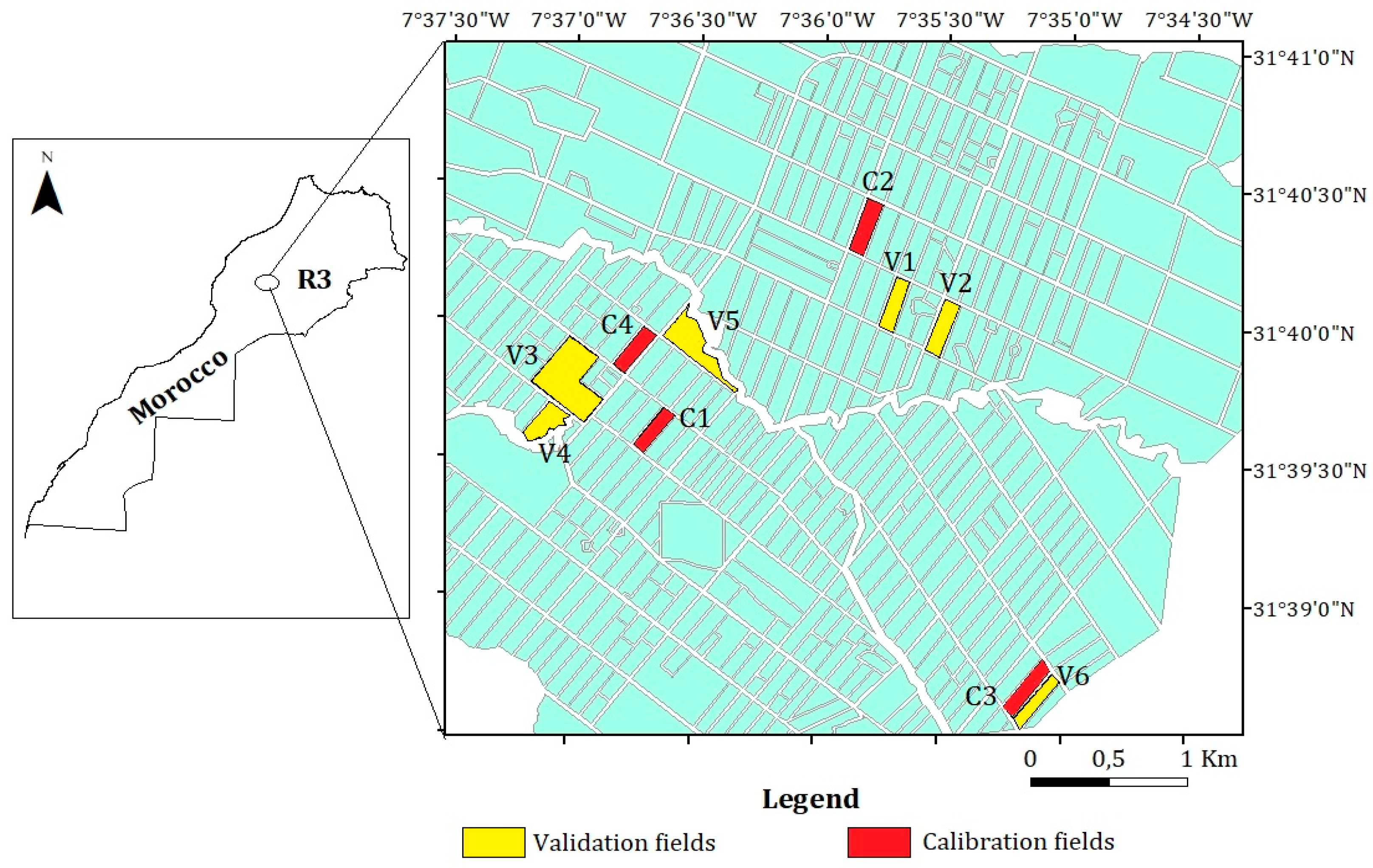
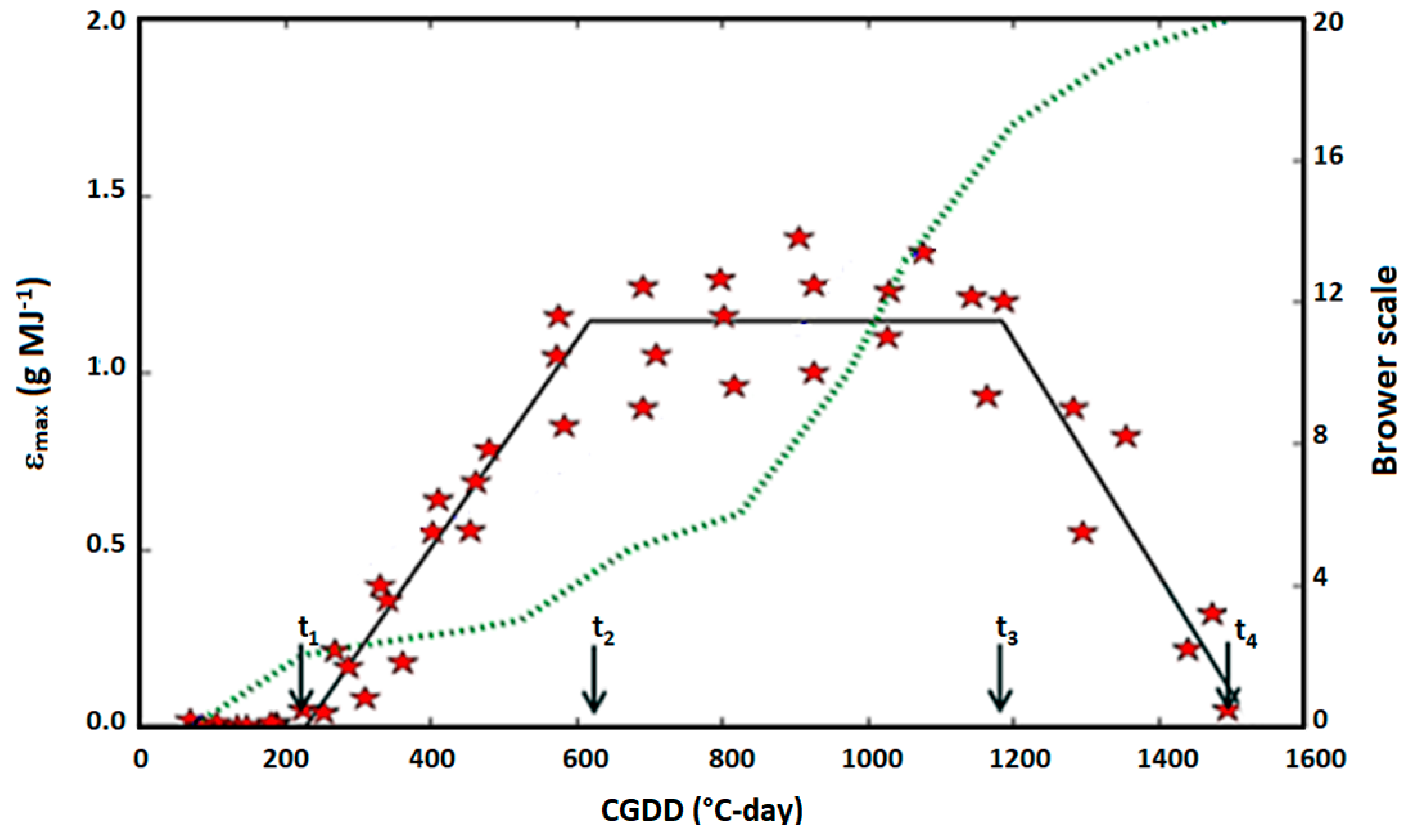

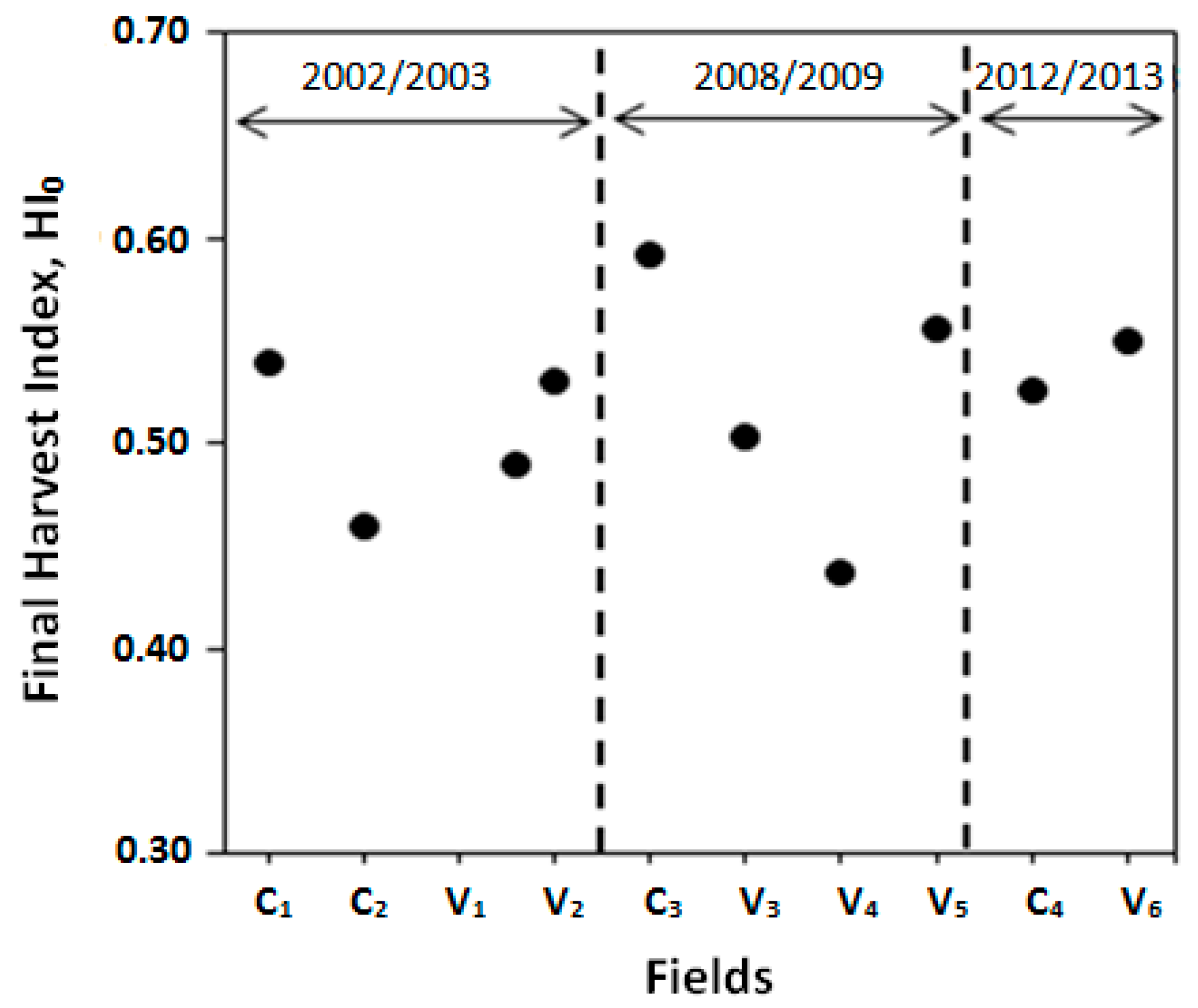
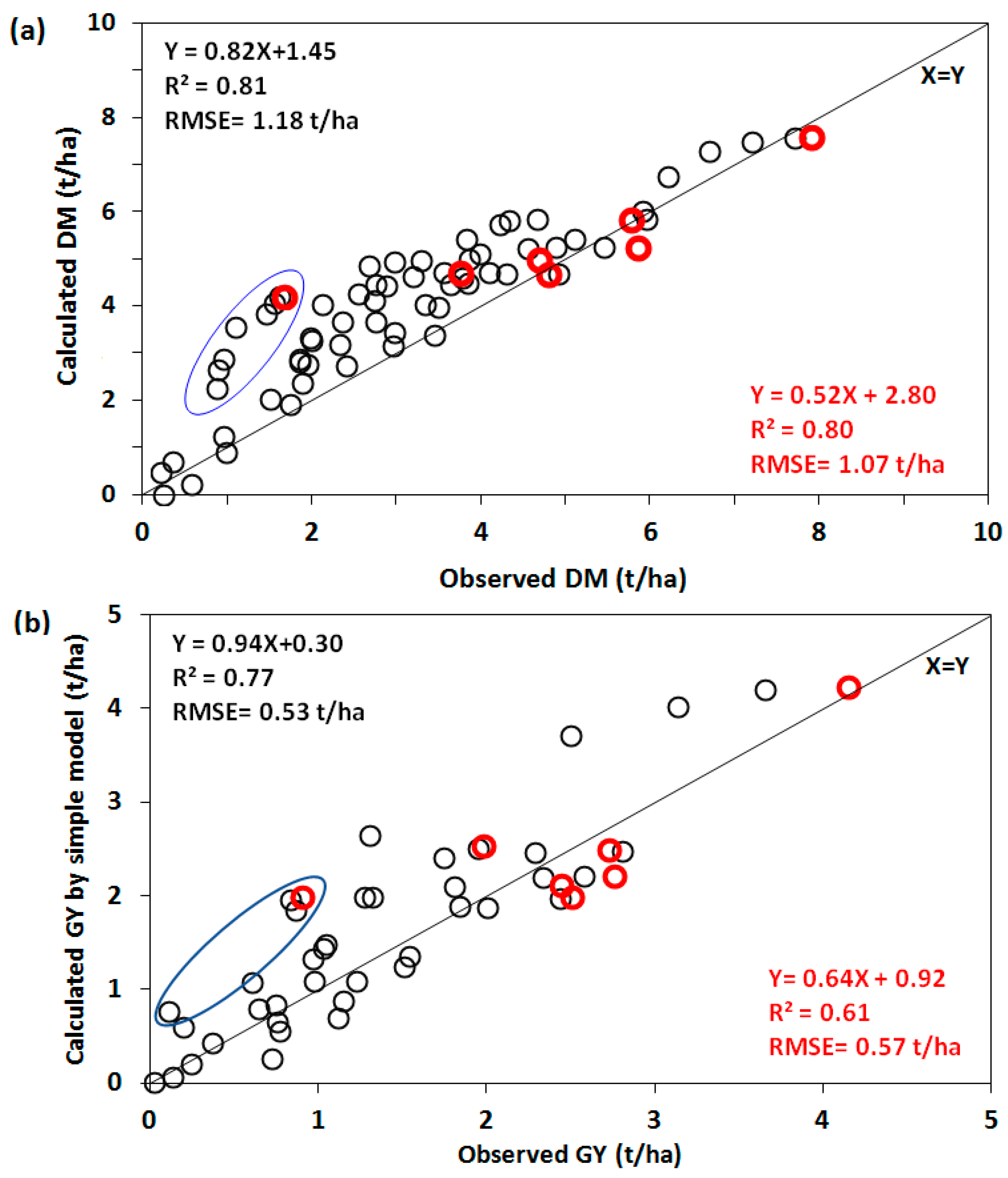
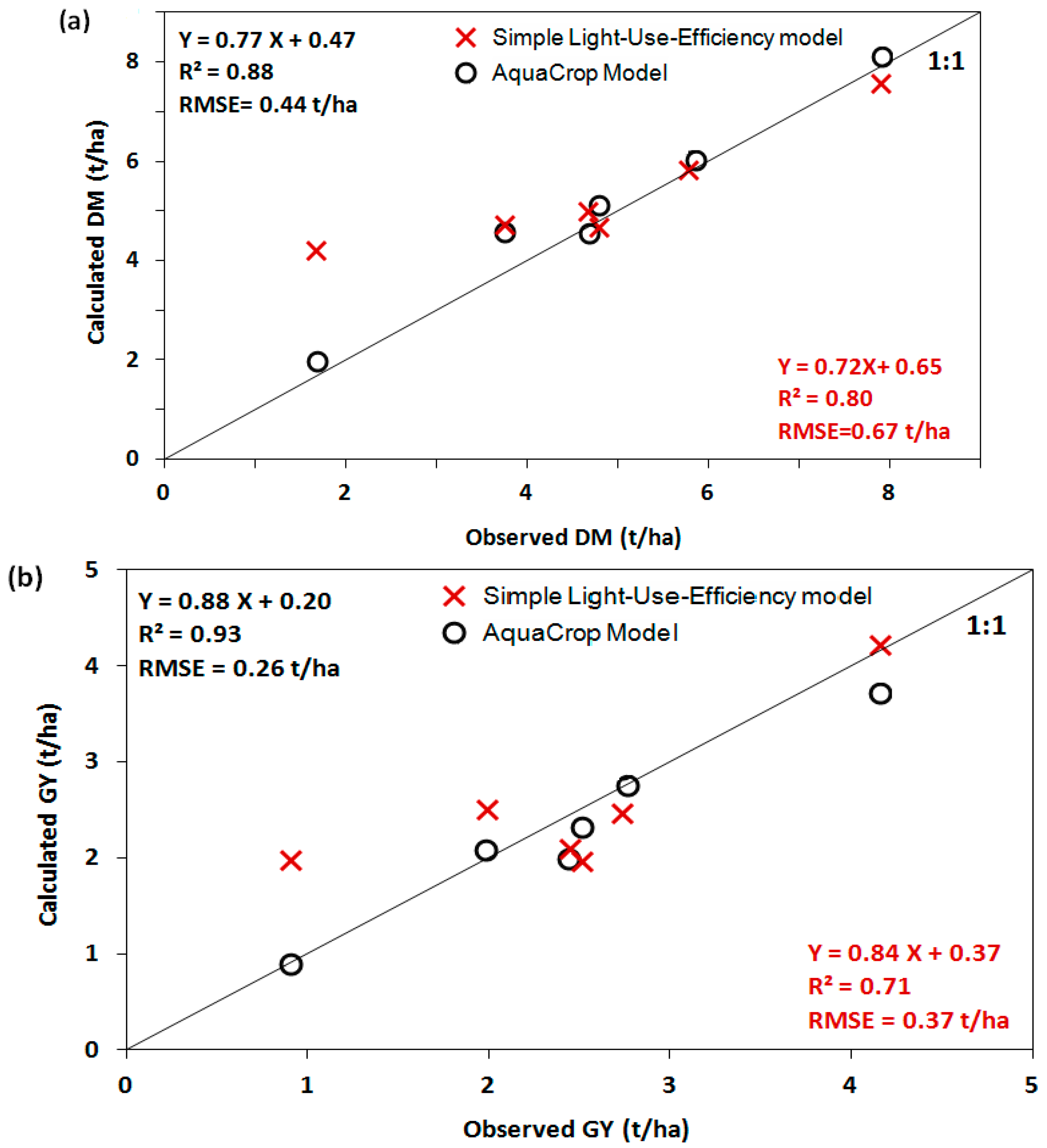

| Year | 2002/2003 | 2008/2009 | 2012/2013 | |||||||
|---|---|---|---|---|---|---|---|---|---|---|
| Field | C1 | C2 | V1 | V2 | C3 | V3 | V4 | V5 | C4 | V6 |
| DM (t/ha) | 5.89 | 3.75 | 1.67 | 4.79 | 5.95 | 4.91 | 5.81 | 4.67 | 7.90 | 8.04 |
| GY (t/ha) | 2.87 | 1.98 | 0.9 | 2.51 | 2.81 | 2.44 | 2.96 | 2.44 | 4.15 | 4.42 |
| Year | Satellite Images | Images Number | Resolution (m2) |
|---|---|---|---|
| 2002/2003 | Landsat-TM7 | 5 | 30 |
| SPOT4 | 3 | 20 | |
| SPOT5 | 2 | 10 | |
| 2008/2009 | Landsat-TM5 | 16 | 30 |
| 2012/2013 | SPOT4 | 13 | 10 |
| Landsat8 | 5 | 30 |
| Notation | Description | Unit | Value | |
|---|---|---|---|---|
| Inputs | NDVI | Normalized Difference Vegetation Index | - | - |
| Rg | Incoming solar radiation | MJ/m2 | - | |
| Ta | Daily average air temperature | °C | - | |
| P | Rainfall | mm | - | |
| I | Irrigation | mm | - | |
| Constants | Tmin, Topt, Tmax | Temperature for growth | °C | 5, 26, 33 |
| NDVImax | Maximum value of NDVI | - | 0.92 | |
| NDVImin | Minimum value of NDVI | - | 0.14 | |
| εi | Climatic efficiency | - | 0.48 | |
| θfc | Soil moisture at field capacity | m3/m3 | 0.32 | |
| θwp | Soil moisture at wilting point | m3/m3 | 0.17 | |
| HI0 | Final harvest index | - | 0.50 * | |
| HI0max | Maximum value of HI0 | - | 0.59 * | |
| ∆HI0 | Variation range of HI0 | - | 0.15 * | |
| Outputs | DM | Aboveground dry matter | t/ha | - |
| GY | Grain yield | t/ha | - |
© 2020 by the authors. Licensee MDPI, Basel, Switzerland. This article is an open access article distributed under the terms and conditions of the Creative Commons Attribution (CC BY) license (http://creativecommons.org/licenses/by/4.0/).
Share and Cite
Khabba, S.; Er-Raki, S.; Toumi, J.; Ezzahar, J.; Ait Hssaine, B.; Le Page, M.; Chehbouni, A. A Simple Light-Use-Efficiency Model to Estimate Wheat Yield in the Semi-Arid Areas. Agronomy 2020, 10, 1524. https://doi.org/10.3390/agronomy10101524
Khabba S, Er-Raki S, Toumi J, Ezzahar J, Ait Hssaine B, Le Page M, Chehbouni A. A Simple Light-Use-Efficiency Model to Estimate Wheat Yield in the Semi-Arid Areas. Agronomy. 2020; 10(10):1524. https://doi.org/10.3390/agronomy10101524
Chicago/Turabian StyleKhabba, Saïd, Salah Er-Raki, Jihad Toumi, Jamal Ezzahar, Bouchra Ait Hssaine, Michel Le Page, and Abdelghani Chehbouni. 2020. "A Simple Light-Use-Efficiency Model to Estimate Wheat Yield in the Semi-Arid Areas" Agronomy 10, no. 10: 1524. https://doi.org/10.3390/agronomy10101524
APA StyleKhabba, S., Er-Raki, S., Toumi, J., Ezzahar, J., Ait Hssaine, B., Le Page, M., & Chehbouni, A. (2020). A Simple Light-Use-Efficiency Model to Estimate Wheat Yield in the Semi-Arid Areas. Agronomy, 10(10), 1524. https://doi.org/10.3390/agronomy10101524








